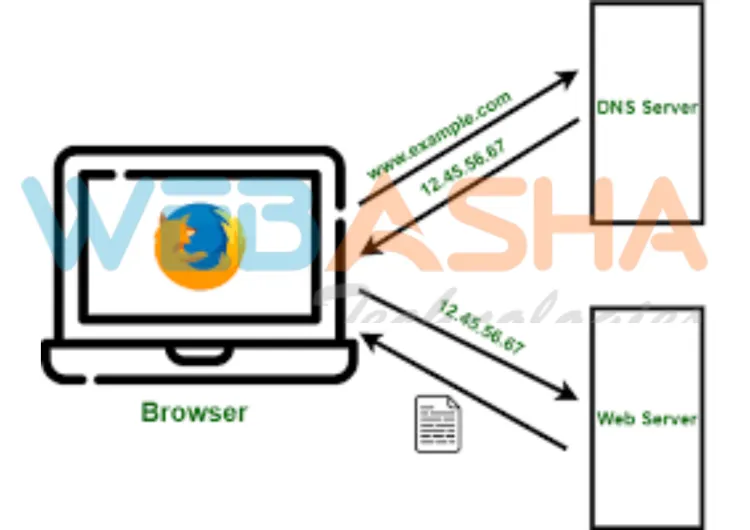How Does the Domain Name System (DNS) Work and Power the Internet? The Complete Guide
DNS (Domain Name System) is a crucial part of the internet, functioning as a "phonebook" that translates human-readable domain names into machine-readable IP addresses, allowing seamless access to websites and online services. It operates through a hierarchical system of servers, including root, TLD, and authoritative servers, which help resolve domain names. DNS also includes important components like DNS records (A, MX, CNAME, etc.), DNS resolvers, and caching to speed up browsing. While DNS ensures efficient navigation, it is also vulnerable to cyberattacks, which can be mitigated using security features like DNSSEC. Understanding DNS is essential for improving internet speed, security, and troubleshooting.

The Domain Name System (DNS) is the backbone of the internet, making it easy for us to access websites without remembering complicated numbers like IP addresses. Let’s dive into DNS, understand its working, and see how it helps us navigate the internet, explained with real-life examples.
What is DNS?
Imagine you want to call your friend Alex. You likely don’t remember Alex’s phone number but have their name saved in your phonebook. Similarly, the internet uses DNS to match domain names like www.google.com to their corresponding IP addresses (e.g., 142.250.74.238).
Key Benefits of DNS
- User-Friendly: You can type
www.facebook.cominstead of157.240.22.35. - Scalability: It efficiently manages billions of domain names.
- Fault Tolerance: Keeps the internet running even if some servers fail.
How DNS Works
Let’s see how DNS works step-by-step with a relatable example:
Step 1: The User Request (DNS Resolver)
You type www.netflix.com into your browser. Your device doesn’t know Netflix’s IP address, so it asks a DNS Resolver (like Google DNS or your ISP’s DNS server) for help.
Step 2: Contacting the Root Name Server
The resolver acts like a librarian. It first contacts the Root Name Server, the main directory, which doesn’t know Netflix’s IP but points to the .com section.
Step 3: Checking the TLD Server
The Top-Level Domain (TLD) Server for .com directs the resolver to Netflix’s Authoritative Name Server.
Step 4: Getting the IP Address
The Authoritative Name Server provides Netflix’s IP address (e.g., 35.190.27.234). Your browser then uses this IP to connect to Netflix and load the website.
Real-Life Analogy:
Think of the root server as asking a mall receptionist where a specific store is. They direct you to the correct floor, and the store directory there gives you the exact location.

DNS Architecture
The DNS system functions like a hierarchical phonebook:
1. Root Name Servers
- The starting point for all DNS queries.
- There are only 13 root servers worldwide, with backups globally.
- They act like the table of contents in a book.
2. Top-Level Domain (TLD) Servers
- Handle extensions like
.com,.org, or.net. - Example: For
www.amazon.com, the.comTLD server guides the query further.
3. Authoritative Name Servers
- Store specific domain details.
- Example: Netflix’s server knows that
www.netflix.commaps to35.190.27.234.
4. DNS Resolver
- Acts as an intermediary between your device and the DNS servers.
- Example: Public DNS resolvers like Google DNS (8.8.8.8) or Cloudflare DNS (1.1.1.1).
Types of DNS Records
DNS records define how the system handles domain requests.
- A Record: Maps a domain to an IPv4 address.
- Example:
www.google.com → 142.250.74.238.
- Example:
- AAAA Record: Maps a domain to an IPv6 address.
- Example:
www.facebook.com → 2a03:2880:f12f:83:face:b00c::25de.
- Example:
- CNAME Record: Redirects one domain to another.
- Example:
blog.example.com → www.example.com.
- Example:
- MX Record: Directs emails to mail servers.
- Example: Emails for
@gmail.comgo to Google’s mail servers.
- Example: Emails for
- TXT Record: Used for verification and security.
- Example: Verifying a domain for Google Workspace.
Real-Life Applications of DNS
-
Streaming Services:
When you visitwww.youtube.com, DNS quickly finds its server’s IP, ensuring you can stream videos seamlessly. -
Online Shopping:
DNS resolveswww.amazon.into the closest server, improving the site’s speed and responsiveness. -
Smart Devices:
Your smart speaker uses DNS to connect to services like Spotify or Alexa.
DNS Caching: Speeding Things Up
DNS caching stores resolved queries temporarily to speed up browsing.
Example:
You visit www.twitter.com. Your resolver caches its IP. The next time you access Twitter, your browser skips the DNS query, making the process faster.
DNS Security: Protecting the Internet
While DNS is essential, it can be vulnerable to cyberattacks. Common threats include:
- DNS Spoofing: Redirecting
www.bank.comto a fake site. - Phishing Attacks: Using lookalike domains like
www.ban-k.com. - DDoS Attacks: Overloading servers with massive traffic.
How to Secure DNS
-
Use Secure Protocols:
Example: Enable DNSSEC (DNS Security Extensions) to verify DNS data. -
Monitor DNS Traffic:
Tools like firewalls can detect unusual patterns. -
Use Reliable Public DNS Servers:
Examples: Google DNS (8.8.8.8) or Cloudflare DNS (1.1.1.1).
Common DNS Tools for Troubleshooting
- nslookup: Query DNS servers for records.
- Example:
nslookup www.google.com.
- Example:
- dig: Perform advanced DNS queries.
- Example:
dig www.github.com.
- Example:
- ping: Check if a domain is reachable.
- Example:
ping www.reddit.com.
- Example:
- traceroute: Trace the path to a domain.
- Example:
traceroute www.amazon.com.
- Example:
Why is DNS Important in Cybersecurity?
Attackers exploit DNS vulnerabilities to redirect users or overload servers.
- DNS Spoofing: Redirecting users to malicious sites.
- Phishing: Using fake domains to steal sensitive information.
- DNS Amplification: A form of DDoS attack to overwhelm servers.
Solution:
Use DNSSEC to ensure data authenticity and prevent these attacks.
Conclusion
DNS simplifies internet use by allowing humans to interact with domain names instead of complex IP addresses. By understanding how DNS works and securing it against vulnerabilities, you gain a deeper appreciation of how this “phonebook of the internet” keeps the digital world connected.
Takeaway:
Explore tools like nslookup or dig to see how DNS resolves your favorite websites. It’s fascinating and essential for networking and cybersecurity!
Got questions or insights? Share them in the comments below!
FAQ:
1. What is DNS, and why is it important?
DNS (Domain Name System) is like the internet’s phonebook. It translates human-readable domain names (e.g., www.google.com) into machine-readable IP addresses (e.g., 142.250.74.238), allowing seamless access to websites and online services.
2. How does DNS work in simple terms?
When you type a domain name into your browser:
- Your device contacts a DNS Resolver.
- The resolver queries various servers (Root, TLD, and Authoritative) to find the domain's IP address.
- The IP address is sent back to your browser, which connects to the website.
3. What are DNS records, and why are they important?
DNS records are instructions that tell the DNS system how to handle a domain. Key types include:
- A Record: Maps a domain to an IPv4 address.
- MX Record: Directs emails to mail servers.
- CNAME Record: Points one domain to another.
4. What is a DNS Resolver, and how is it different from a Name Server?
- DNS Resolver: A client-side system that resolves domain names by querying various DNS servers.
- Name Server: A server-side system that stores DNS records and responds to queries.
5. What is DNS caching, and how does it speed up browsing?
DNS caching temporarily stores resolved domain queries (IP addresses). When you revisit a website, the cached data is used instead of querying DNS servers again, speeding up the process.
6. What is DNSSEC, and why is it important?
DNSSEC (DNS Security Extensions) adds a layer of security to DNS by digitally signing DNS data, ensuring its authenticity and protecting against attacks like DNS spoofing.
7. What happens if DNS fails?
If DNS fails:
- Websites may become unreachable because browsers can’t resolve domain names to IP addresses.
- Services like email, streaming, and apps relying on DNS can stop working.
8. What are public DNS servers, and which are the best to use?
Public DNS servers are DNS resolvers available for anyone to use. Popular ones include:
- Google DNS:
8.8.8.8and8.8.4.4. - Cloudflare DNS:
1.1.1.1and1.0.0.1.
9. How is DNS used in cybersecurity attacks?
Attackers exploit DNS in various ways:
- DNS Spoofing: Redirecting users to fake websites.
- DNS Amplification: Leveraging DNS queries for DDoS attacks.
- Phishing: Using lookalike domains to steal sensitive data.
10. Can I change my device’s DNS settings?
Yes, you can change DNS settings on your device or router to use faster or more secure DNS servers like Google DNS (8.8.8.8) or Cloudflare DNS (1.1.1.1). This can improve speed and security.











![Top 10 Ethical Hackers in the World [2025]](https://www.webasha.com/blog/uploads/images/202408/image_100x75_66c2f983c207b.webp)



![[2025] Top 100+ VAPT Interview Questions and Answers](https://www.webasha.com/blog/uploads/images/image_100x75_6512b1e4b64f7.jpg)







